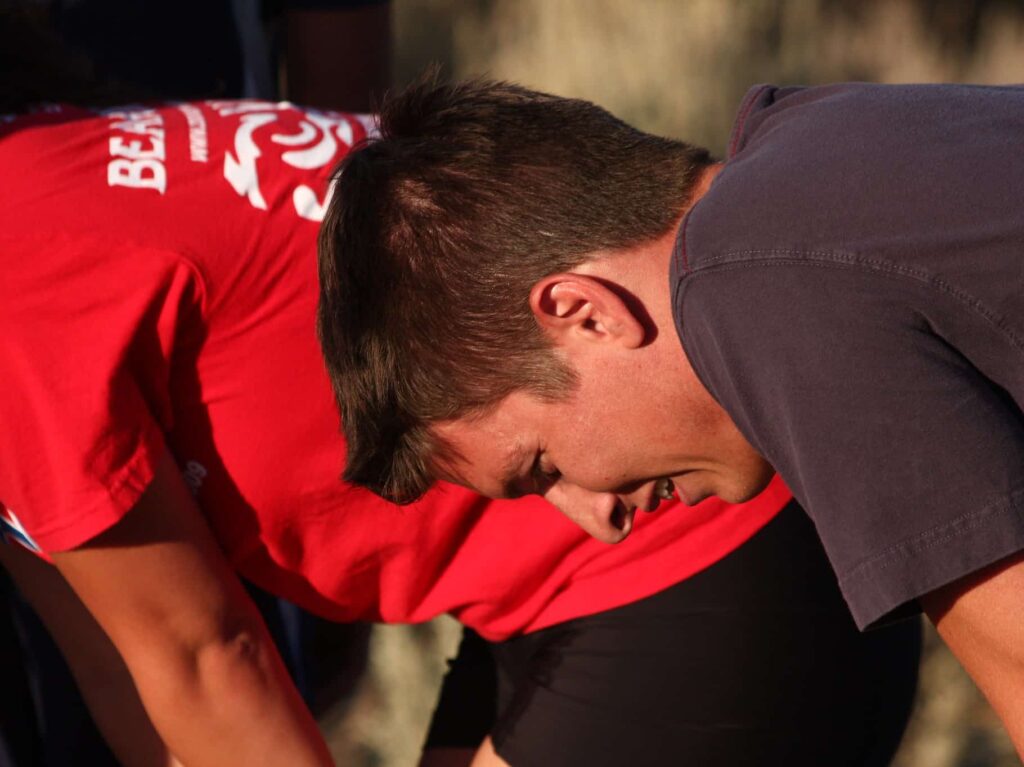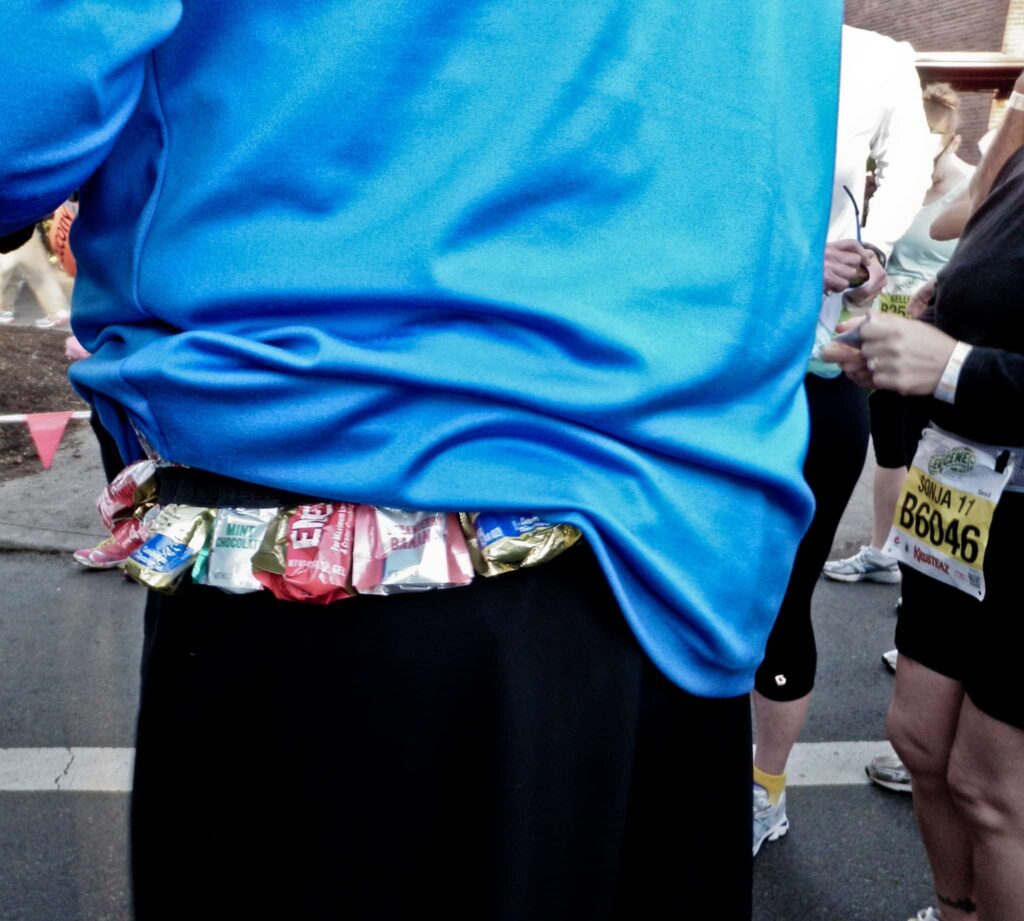Last updated on January 23rd, 2023 at 10:10 am
Ask any distance runner, and chances are they use energy gels for refueling. But if you’re new to the idea refueling can be confusing. Learning the answer to ‘how should gels be spaced during ultramarathons?’ is essential to maintain a balanced caloric intake during ultrarunning.
While ultrarunners are accustomed to being calorie deficient, refueling with gels correctly lets you replenish enough calories to prevent bonking.
How Many Calories do Ultrarunners burn?
First, it’s important to understand every runner’s caloric expenditure is different. Generally speaking, however, burning through 100 calories per mile is average, or 400-600 calories an hour.
Sadly, for ultrarunners, caloric output is always greater than caloric intake meaning endurance runners continually operate in the red.
Truly, the body is only able to absorb between 240-360 calories per hour. And for ultramarathons, this means two very important things:
- You need to start fully charged
- Start refueling early and regularly to avoid hitting the wall.
Astonishingly, your body can deplete all its glucogen fuel within the first 90 minutes of a run. So, without constant refueling, you’ll crash and burn. If you’re wondering how to carry your gels and other food, we found the best running vests for the sport in our Best Hydration Vests for Trail Running and Ultrarunning post.
For example, bonking results in sudden fatigue, nausea, dizziness, shakiness, cramping, muscle weakness, and low blood sugars. In turn, low blood sugars left unchecked can lead to unconsciousness.
Equally important, bonking has a huge impact on your mental game.
To illustrate, glucose is the only carb the brain utilizes. Without it, your brain tells the body to stop. You become enveloped by defeat and feel you can’t go on.
Ultimately, bonking ends your race. So, to answer ‘how should gels be spaced during ultramarathons’ we’ll go into more depth below to illustrate strategies to balance your calorie intake. I’ts essential to avoid bonking.
How Should Gels be Spaced During Ultramarathons:
1. Plan Your Calorie Intake before Ultramarathons
By refueling early and systematically, you ensure that you don’t crash and burn. Using the numbers above, it’s easy enough to plan your food consumption. And, when wondering ‘how should gels be spaced during ultramarathons’ planning is as easy as dividing your forecasted loss by the quantity of calories in a gel. Then also considering other food you’ll consume such as protein as discussed below.
First, start with the pre-race meal to restore liver glycogen that gets depleted through the night. Make sure you eat at least three hours before start time. Aim for around 200-400 high carb, low fat and fiber, easily digestible calories.

This ensures a full tank with maximum fuel efficiency. Additionally, it lets you settle into your pace and find your groove before refueling.
Common pre-race meals include:
- Toast with a piece of fruit or jelly
- Rice cakes with nutbutter and banana
- Fruit and yogurt smoothie
- Nutbutter mixed with molasses or honey
2. When to Begin Refueling
Once off the starting line, begin refueling around 45 minutes to an hour into your run (assuming you ate breakfast). Don’t wait until your energy levels drop.
Following your first refuel, repeat every 15 to 20 minutes.
For the first several hours, it’s safe, but not required, to operate on carbohydrates alone.
In fact, many ultrarunners stick to solid foods in the beginning, saving their gels for the end game. Furthermore, it’s easier to digest solid foods early on.
When refueling, keep your carb count to less than or equal to 100 calories per hour and spaced over routine intervals. You should refrain from ingesting too much sugar at one time.
After about eight hours, however, you need to gradually introduce proteins.
Furthermore, limiting carbs at routine intervals helps keep your GI tract and bloodstream in optimal condition.
For instance, when the body is under duress, it instinctively diverts blood away from the digestive tract to wherever it is needed. Therefore, marathon running eventually causes the stomach to slow or shut down.
Additionally, glucose gels are absorbed first into the blood before they are absorbed into the muscles. This takes time. Too much sugar in the bloodstream at once will make you sick.
Of course, each runner’s needs are unique, so some analysis and experimentation are required.
What are Energy Gels

Energy gels are simple sugars made for quick absorption allowing the body to react almost instantaneously. Much like diabetics require glucose during hypoglycemia, runners need glucose to prevent total depletion and bonking.
Furthermore, the body primarily uses fats and carbohydrates for energy. And, because fats take entirely too long to process, runners rely on carbohydrates to get the job done.
Race day performance relies entirely on the glycogen contained in your muscles.
But, because the body only has about 90 minutes of muscle glycogen stored, runners need much more to sustain ultramarathons. And considering the digestive issues mentioned above, gels are much easier to process and convert to energy.

Essentially, gels provide runners with the necessary fuel to keep running. Plus, they’re compact and portable to be stuffed into pockets, waistbands, or sorts bras for later.
In short, energy gels are small portable running supplements that help you sustain energy during training, long competitions, or between aid stations.
Brands we love include GU, Honey Stinger, CLIF, MUIR, and Huma. Plus, energy gels offer a great incentive and morale boost when you need them.
3. How Should Gels be Space During Ultramarathons:
Consider Taste Bud Fatigue During the Race
Additionally, just like your muscles can get overworked, so can your taste buds. And because runners constantly consume food mile after mile, eventually the tongue loses the ability to distinguish among flavors.
For instance, the brain gets overloaded with sensory information, mixes things up, and then sends out false signals.
In layman’s terms, it makes you not want to eat. This is both detrimental to your health and your race.
The biggest threat of palate fatigue is a big, fat DNF. When you don’t eat, you run out of gas. When you run out of gas, you don’t make the finish line.
Common causes of taste bud exhaustion include:
- Consistently eating or drinking the same thing
- Nausea, vomiting, or upset stomach
- Extreme exhaustion
So, trying to sustain on gels alone would be a huge mistake and virtually guarantee sensory enervation. Additionally, when planning your refuels, consider including lots of different flavors and brands to avoid tastebud fatigue.
4. How Should Gels be Spaced During Ultramarathons:
Consider Calorie Goals per Distance
The following table is based on the most common ultramarathons and a calorie intake of 240-360 calories per hour (source). We’ve calculated a typical runners caloric intake for several popular ultra lengths. This can be used to help you plan your spacing based on how many calories your gels and solid foods can offer.
Ultramarathon Distance | Average Run Time | At 240 calories/hour | At 360 calories/hour |
50K (31 miles) | 6.75 hours | 1,620 calories | 2,430 calories |
100K (62 miles) | 16.7 hours | 4,008 calories | 6,012 calories |
100 Miles (160K) | 28.21 hours | 6770 calories | 9,591 calories |
As you can see from the above table, calorie needs for the most popular ultras will be difficult to sustain on just gels. Let alone just one type and flavor considering gels are usually 100-150 calories each. The best way to avoid sensory enervation is to switch it up as much as you can. v
Not only should you consider having a variety of brands and flavors within your gels, you should also add a variety of other foods as well.
Popular choices include:
- Ensure
- Energy bars and drinks
- Dr. Allen Lim’s Rice Cakes
- Chocolate covered espresso beans, nuts, or raisins
- Salted potato wedges
- Pretzels
- PB&J
- Coffee or flat Coke
When you consider the average daily diet is 1200 – 2000 calories, ultramarathoners require a boatload of carbohydrates. The more variety, the less chance of both mental and palate fatigue.

5. How Should Gels be Spaced during Ultramarathons:
Balance your Fuel Intake
Furthermore, remember, too much sugar in the bloodstream is a bad thing. When too many simple sugars infiltrate your system, they pull fluids and electrolytes from the body. This, in turn, causes gastric stress and fatigue.
This is why it’s imperative to introduce protein after 8-10 hours. Some experts suggest as early as the 4th hour.
Moreover, it should be consumed at a ratio of one part protein to 4 parts carbohydrates.
For instance, protein is necessary for maintaining muscle and tissue repair, increasing white blood cells, and preventing muscle loss.
And over time, protein is also converted into carbs, which helps sustain your energy levels and replenish depleted reserves.
6. Proper Hydration is Important for Ultras
Finally, dehydration is also a big concern for distance runners. And, determining the amount of liquid you should consume is crucial to a successful run.
And while staying hydrated is imperative, overhydrating causes low blood sodium, also known as hyponatremia. Likewise, so does underhydrating. Finding balance is key.
So, to prepare for race day, many runners calculate their sweat rate.
To do so, follow these steps:
Remove clothing, weigh yourself, and record the weight.
- While practicing a run, record all of your fluid intake.
- Following your run, in the same manner, weigh again.
- Find the difference between the start weight and end weight. Then add all your fluid intake.
- Divide by 60 to determine the amount of lost fluid per hour. This is your sweat rate.
Each pound of weight lost is equal to 16 ounces of fluid. The goal for long-distance runs is to replace at least 70% of that number. Therefore, multiply your sweat rate by .7 to determine how many ounces to drink in one hour.
Furthermore, on race day make sure you’re well hydrated before the race begins. Check your urine approximately two hours ahead of time. It should be pale yellow in color. If not, you have a couple of hours to get yourself up to par. Additionally, to help you stay hydrated and carry your gels, we’ve outlined some really amazing running belts in our Best Hydration Running Belts for Ultrarunning post.

Fuel Up Properly
Trying to figure out your nourishment needs for an ultramarathon can make your head spin. While it seems like a bunch of complex math and science, once you wrap your head around it, it’s fairly easy. Overall, it’s well worth the effort to keep your body running smoothly for the next hundred miles.
Furthermore, ensuring that you have adequate caloric and hydration intake prevents you from a DNF. Fill up early, refuel frequently, and keep putting one foot in front of the other. You’ll cross the finish line before you know it.
And, for when you finally finish your first ultra, we recommend some of the best recovery aids in our Best Cold Compression Therapy Machines post.
Todd Alexander
RELATED POSTS:
Title Image Credit, How Should Gels be Spaced during Ultramarathons: JULIAN MASON | (source) | attribution 2.0 Generic (CC BY 2.0) — reduced file size and image
How Should Gels be Spaced during Ultramarathons, Image Credit 1: Rennett Stowe | (source) | Attribution 2.0 Generic (CC BY 2.0) — reduced file size and image
How Should Gels be Spaced during Ultramarathons, Image Credit 2: Michael (a.k.a. moik) McCullough | (source) | Attribution 2.0 Generic (CC BY 2.0) — reduced file size and image
How Should Gels be Spaced during Ultramarathons, Image Credit 3: Peter Mooney | (source) | Attribution-ShareAlike 2.0 Generic (CC BY-SA 2.0) — reduced file size and image
Image Credit 4, How Should Gels be Spaced during Ultramarathons: Stephen and Helen Jones | (source) | Attribution-ShareAlike 2.0 Generic (CC BY-SA 2.0) — reduced file size and image

